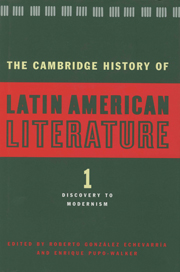Book contents
- Frontmatter
- Introduction to Volume 1
- 1 A brief history of the history of Spanish American Literature
- 2 Cultures in contact: Mesoamerica, the Andes, and the European written tradition
- 3 The first fifty years of Hispanic New World historiography: the Caribbean, Mexico, and Central America
- 4 Historians of the conquest and colonization of the New World: 1550–1620
- 5 Historians of the colonial period: 1620–1700
- 6 Colonial lyric
- 7 Epic poetry
- 8 Spanish American theatre of the colonial period
- 9 Viceregal culture
- 10 The eighteenth century: narrative forms, scholarship, and learning
- 11 Lyric poetry of the eighteenth and nineteenth centuries
- 12 Spanish American theatre of the eighteenth century
- 13 The nineteenth-century Spanish American novel
- 14 The brief narrative in Spanish America: 1835–1915
- 15 The Spanish American theatre of the nineteenth century
- 16 The essay in Spanish South America: 1800 to Modernismo
- 17 The essay of nineteenth-century Mexico, Central America, and the Caribbean
- 18 The gaucho genre
- Index
- Bibliographies
- References
3 - The first fifty years of Hispanic New World historiography: the Caribbean, Mexico, and Central America
Published online by Cambridge University Press: 28 March 2008
- Frontmatter
- Introduction to Volume 1
- 1 A brief history of the history of Spanish American Literature
- 2 Cultures in contact: Mesoamerica, the Andes, and the European written tradition
- 3 The first fifty years of Hispanic New World historiography: the Caribbean, Mexico, and Central America
- 4 Historians of the conquest and colonization of the New World: 1550–1620
- 5 Historians of the colonial period: 1620–1700
- 6 Colonial lyric
- 7 Epic poetry
- 8 Spanish American theatre of the colonial period
- 9 Viceregal culture
- 10 The eighteenth century: narrative forms, scholarship, and learning
- 11 Lyric poetry of the eighteenth and nineteenth centuries
- 12 Spanish American theatre of the eighteenth century
- 13 The nineteenth-century Spanish American novel
- 14 The brief narrative in Spanish America: 1835–1915
- 15 The Spanish American theatre of the nineteenth century
- 16 The essay in Spanish South America: 1800 to Modernismo
- 17 The essay of nineteenth-century Mexico, Central America, and the Caribbean
- 18 The gaucho genre
- Index
- Bibliographies
- References
Summary
Within fifty years of Columbus’s landing, the sedentary areas of Latin America had been conquered by Spain, inaugurating its Golden Age. Sieges of the new-found lands took on epic dimensions and reaped victories of monumental importance for the Spanish church and state. The Spanish soldiers themselves were said to rival the ancient Romans for their loyalty and heroism in conquest as time and again the few vanquished the many.
Focusing our sights on the first wave of conquests in the Caribbean, Mexico, and Central America, however, we are struck by an ironic if perhaps inevitable fact: that this larger tissue of Spanish victories, heroism and loyalty was woven in significant ways of failures and transgressions. Less than heroic actions underlie and even enable the eventual victories. Of course, the whole Discovery and Conquest rests on Columbus’s original miscalculations. However, let us not forget, to mention but a few egregious examples, that Columbus was later sent back to Spain in chains; that the conquest of Mexico issued from Hernán Cortés’s disobedience of Diego Velázquez; that Alvar Núñez Cabeza de Vaca’s peregrinations of discovery across the North American southwest to Mexico were occasioned by the shipwreck and deaths of his companions. Disobedience of superiors, cruelty to the native populations, self-interest, failed attempts at religious conversion, incomprehension of the New World, and so on, form the landmarks in a ‘thick’ description of the Conquest, as seen from within.
- Type
- Chapter
- Information
- The Cambridge History of Latin American Literature , pp. 58 - 100Publisher: Cambridge University PressPrint publication year: 1996
References
- 1
- Cited by



